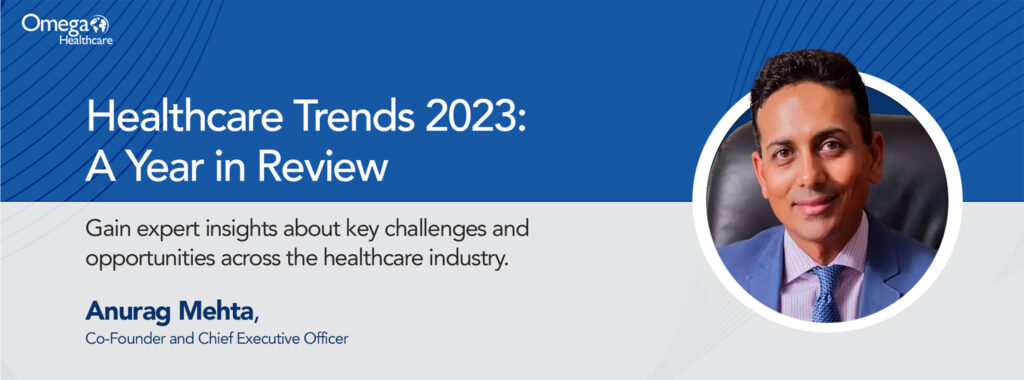By Chris Rigsby, SVP Payer Solutions
For payers, 2024 was a challenging year.
Sweeping policy changes squeezed reimbursement, and rising medical utilization sent costs soaring. Managed care stocks underperformed significantly, plummeting 13 percent and lagging far behind the S&P 500’s 23 percent growth, as investors reacted to worsening margin pressures and growing regulatory scrutiny.
According to McKinsey, the economic pressures payers currently face are “likely to last a few years.”
The challenges are stark. But, there are promising opportunities available to reduce exposure in the uncertain times ahead.
Read on to explore four key developments impacting payer operations this year — and how member-centricity, strategic partnerships, and smart AI adoption can help them stay ahead of the trends in 2025 and beyond.
Financial Pressures Will Continue to Mount
According to the NAIC’s 2024 Mid-Year Health Insurance Industry Analysis report, health plans’ aggregated net income fell 14 percent in the first six months of 2024 compared to the same period the prior year. As income decreased and the loss ratio climbed to 87.1 percent, cash flow from operations plummeted 86 percent — a drastic liquidity shift that could impact future investment in payer infrastructure.
In short: Payers are grappling with financial strain — and that strain is mounting.
Major shifts in payer mix and utilization trends are key contributors. For example, rising Medicare enrollment — up 10 percent in 2024 — and declining Medicare premiums — down 9 percent last year — are creating an imbalance in risk adjustment calculations and forcing payers to adjust pricing strategies to compensate for shifting risk pools.
Rising provider costs and inflationary pressures are also to blame: Hospital and medical expenses rose 7 percent ($35 billion) in the first half of 2024. Internally, administrative costs and operational inefficiencies are constant sources of financial waste.
These trends are expected to continue — which means traditional cost-cutting measures, including administrative downsizing and contract renegotiation, will no longer be enough to offset the pressures.
What This Means for Payers
- Spending on member care (i.e., care coordination, utilization management, value-based care gap closure) and engagement should be coordinated for maximum impact. Payers should continue to invest in programs that offer multiple benefits at once rather than spreading resources across fragmented initiatives. This means integrating engagement strategies across risk adjustment, quality improvement, care management, and utilization management to optimize every member interaction and outcomes.
- Recalibrate financial models to adjust for shifting risk pools. Payers need to adjust their pricing strategies and risk models to remain financially viable. Outcome-based pricing models, per-member-per-month (PMPM) agreements, and risk-sharing contracts will be key to ensuring cost predictability, sustainable reimbursement structures, and member care quality.
- Administrative cost-cutting will reshape payer operations. As margins shrink, layoffs and outsourcing trends are expected to rise. Rather than cutting costs indiscriminately, payers need to balance cost reductions with operational effectiveness. Partnering with external experts for claims processing, utilization review, and provider data management can help payers scale operations, improve accuracy, and drive cost savings — without sacrificing service quality. Payers should prioritize partners that are willing to align with financial structures based on performance and risk sharing.
- Make the switch to proactive provider contract management. With hospital and medical expenses rising, payers should develop cost-containment strategies that don’t compromise network adequacy. Alternative reimbursement models, such as bundled payments and shared risk agreements, can help control escalating provider costs while maintaining positive payer-provider relationships.
AI Adoption Will Determine Competitive Advantage
AI is omnipresent in payer discussions.
McKinsey estimates payers that embrace AI and automation capabilities as part of their operational framework could experience a potential reduction of 13 to 25 percent in administrative expenses, a possible decrease of 5 to 11 percent in medical costs, and a 3 to 12 percent increase in revenue. Under-performing payers could see even greater improvements.
Despite its promise, the impact of AI adoption remains uneven.
Many payers still lack a cohesive strategy for implementing AI at scale. Budget constraints are forcing them to weigh competing priorities to determine where to focus AI investments. Determining how and when AI will develop is guesswork.
Concerns over wrongful denials, transparency, and compliance risks have also slowed adoption. Many payers are hesitant to fully automate critical processes such as utilization management and claims adjudication, especially without concrete ROI.
But, the hard truth is: Payers that fail to prioritize an AI investment strategy now risk falling behind — in both competitive positioning and cost efficiency.
What This Means for Payers
- Prioritize targeted AI applications with measurable ROI. AI-powered claims automation, call center automation, prior authorization, and member engagement offer quick wins that reduce administrative burden and improve workflow efficiency. These tools can enhance payer-provider collaboration, minimize claim disputes, and create a more seamless experience for members.
- Predictive analytics will be a game-changer. AI-driven denial prediction, member risk stratification, and proactive outreach can help payers anticipate costly errors before they occur, improving risk adjustment and quality compliance, member engagement, and care coordination.
- Fraud detection and payment integrity programs must evolve. Healthcare fraud costs the industry tens of billions annually, with improper billing and duplicate claims driving up expenses. Payers should leverage AI-powered fraud analytics to identify suspicious billing patterns, flag improper claims, and prevent financial leakage before payments are issued.
- Hybrid AI-human models work best. While AI can accelerate claims adjudication and fraud detection, it should enhance — not replace — human expertise in high-risk claims processing and appeals. Combining automation with human oversight ensures compliance, accuracy, and provider trust while mitigating risks associated with fully automated denials.
- AI-driven regulatory readiness will be a competitive differentiator. AI-driven automation will be essential for compliance with evolving CMS mandates, including real-time prior authorization processing, payer-to-payer data exchange, and API-driven claims transparency.
- AI integration must be holistic and strategic. To fully realize AI’s potential, payers need to invest in scalable technology infrastructure, improve data governance, and redesign operational workflows. This requires:
- Optimizing data quality and accessibility to fuel AI-driven insights.
- Restructuring operating models to incorporate AI across claims, payments, and risk adjustment.
- Developing AI talent and strategic partnerships to accelerate adoption and maximize ROI.
The Shift Toward Value-Based Care is Accelerating
The healthcare landscape continues to shift from volume to value, with quality outcomes, preventative care, and member engagement taking priority.
Payers are pivoting. HCPLAN’s 2024 annual survey found that 45.2 percent of all healthcare payments flowed through value-based arrangements, a nearly 4 percent increase from 2022. Shared risk arrangements also rose, up from 24.5 percent in 2022 to 28.5 percent in 2023.
Expanding VBC has introduced fresh operational hurdles that require equally expanded solutions. Integrating digital-first engagement tools is now a top priority, and outsourcing has become the necessary second half of a hybrid approach to care coordination, combining localized community outreach and expert partner support.
What This Means for Payers
- Payers should embrace prospective and concurrent risk adjustment activities alongside traditional retrospective activities. Risk adjustment regulatory pressures have intensified — which means accurate and complete risk adjustment coding is more critical than ever. Coding inaccuracies due, in part, to gaps in providers’ knowledge of documentation requirements continue to create compliance and reimbursement challenges, making standardized documentation programs essential. Payers should invest in provider training on HCC coding accuracy and risk adjustment best practices to reduce inconsistencies in risk-adjusted payments, improve reimbursement accuracy, and mitigate audit risks.
- Data-driven quality improvement will define payer success. AI-powered predictive analytics for HEDIS and Star measures can help payers proactively identify care gaps, improve compliance, and enhance risk stratification — ensuring better outcomes while optimizing financial performance.
- Collaboration between payers and providers is key. Along with risk adjustment training programs, equipping providers with tools and actionable clinical information to foster comprehensive documentation capture is imperative — leading to improved provider engagement and increased participation in VBC partnerships.
- Strategic partnerships are the better investment. Too often, outsourcing isn’t enough. As VBC adoption scales, payers will need strategic partners that expertly balance technology enablement and service support. Payers should prioritize vendors with demonstrable ROI and solutions designed to evolve with regulatory and technological shifts.
- Self-service tools will continue to be essential to payer engagement strategies. Digital-first solutions like AI-powered chatbots, member portals, and telehealth platforms improve access to care, reduce reliance on live agents, and enhance member satisfaction. Payers that fail to modernize engagement strategies will struggle with higher call center costs, slower resolution times, and declining member retention.
Payers Are Becoming Care Providers
The lines between payers and providers are blurring. More payers are directly owning or partnering with primary care networks to control costs, manage risk adjustment, and improve member engagement.
The shift is strategic: Preventative care has become a key investment for payers looking to reduce long-term costs through early intervention.
It’s also accelerating. By 2022, UnitedHealth’s Optum employed or affiliated with over 70,000 physicians, making it the largest employer of healthcare practitioners in the U.S., according to the AHA. Walgreens’ acquisitions of CareCentrix and VillageMD similarly underscore how payers are embedding themselves deeper into care delivery.
Beyond traditional ownership models, payers are expanding their footprint in retail clinics, virtual care, and home-based services. Partnerships with in-home lab providers, telehealth platforms, and mobile health solutions allow payers to expand access without requiring brick-and-mortar investments — a shrewd approach as healthcare costs rise and access disparities persist.
What This Means for Payers
- Payers must balance cost control with care quality. Overemphasizing cost reduction at the expense of care quality or access can lead to patient dissatisfaction, regulatory scrutiny, and provider disengagement. Implementing value-based performance metrics within payer-owned clinics will help maintain high-quality care while ensuring operational efficiency.
- Building trust with patients and providers will be essential. Many patients and independent providers are skeptical about payer-driven care models. To succeed, payers need to differentiate their owned-care models from traditional insurance oversight, positioning themselves as care enablers, not gatekeepers. Ensuring seamless referrals, coordinated care transitions, and transparent communication will be critical for building credibility and engagement.
- Compliance and regulatory considerations cannot be overlooked. As payers expand their provider footprint, they will face heightened regulatory oversight. Maintaining clear separation between payer and provider functions, ensuring fair reimbursement models, and adhering to patient protection laws will help mitigate legal and compliance risks.
- Strengthening care integration and data interoperability is critical. Payers must ensure that their clinics and provider partners have access to real-time patient insights to support proactive, data-driven care. Breaking down data silos, improving referral pathways, and leveraging AI-powered decision support tools will enable seamless, high-quality care delivery across settings.
- Primary care enablement is key. Payers need to support provider networks with real-time patient insights, helping to reduce unnecessary ER visits and hospitalizations while ensuring primary care physicians have the tools needed to deliver value-based care. AI-driven clinical decision support, remote monitoring, and real-time claims data can enable more personalized preventative care strategies.
Looking Ahead: The Path Forward for Payers
The payer industry is at a crossroads. Regulatory uncertainty, cost constraints, and AI-driven transformation are reshaping how organizations operate. The pressures are mounting, but so are the opportunities.
At its core, payer success is no longer just about managing risk — it’s about creating value, driving better care outcomes, and fostering trust across the healthcare ecosystem.
The payers that thrive in 2025 and beyond will follow this model, embracing AI responsibly, investing in early intervention, and prioritizing provider collaboration and member engagement.
Ready to Future-Proof Your Operations?
Omega Healthcare delivers the expertise, automation, and technology-driven solutions payers need to streamline administrative and clinical operations, improve VBC results, and enhance member engagement — all while staying in synch with industry changes.
Learn more about how Omega Healthcare’s payer services optimize payers’ bottom-line revenues and competitive advantage.




